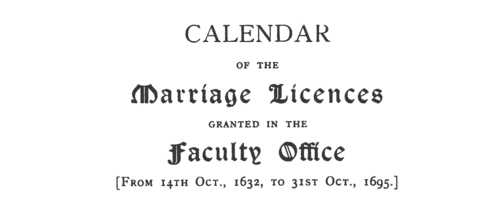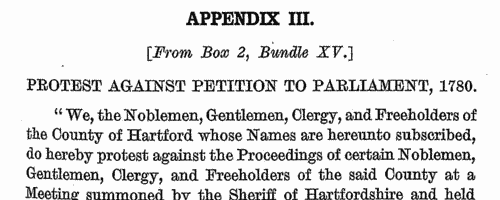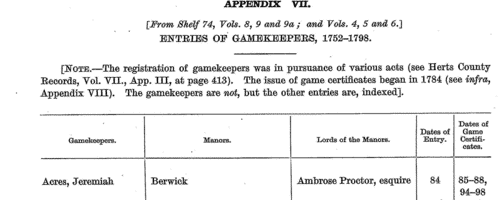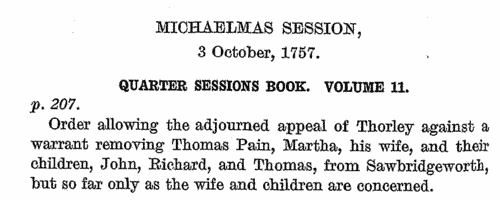Licences for marriages in southern England
(1632-1714)
The province or archbishopric of Canterbury covered all England and Wales except for the northern counties in the four dioceses of the archbishopric of York (York, Durham, Chester and Carlisle). Marriage licences were generally issued by the local dioceses, but above them was the jurisdiction of the archbishop. Where the prospective bride and groom were from different dioceses it would be expected that they obtain a licence from the archbishop; in practice, the archbishop residing at Lambeth, and the actual offices of the province being in London, which was itself split into myriad ecclesiastical jurisdictions, and spilled into adjoining dioceses, this facility was particularly resorted to by couples from London and the home counties, although there are quite a few entries referring to parties from further afield. Three calendars of licences issued by the Faculty Office of the archbishop were edited by George A Cokayne (Clarenceux King of Arms) and Edward Alexander Fry and printed as part of the Index Library by the British Record Society Ltd in 1905. The first calendar is from 14 October 1632 to 31 October 1695 (pp. 1 to 132); the second calendar (awkwardly called Calendar No. 1) runs from November 1695 to December 1706 (132-225); the third (Calendar No. 2) from January 1707 to December 1721, but was transcribed only to the death of queen Anne, 1 August 1714. The calendars give only the dates and the full names of both parties. Where the corresponding marriage allegations had been printed in abstract by colonel Joseph Lemuel Chester in volume xxiv of the Harleian Society (1886), an asterisk is put by the entry in this publication. The licences indicated an intention to marry, but not all licences resulted in a wedding. PUDDEFOOT. Cost: £4.00.  | Sample scan, click to enlarge

|
 Masters of Apprentices
(1759) Masters of Apprentices
(1759)
Apprenticeship indentures and clerks' articles were subject to a 6d or 12d per pound stamp duty: the registers of the payments usually give the master's trade, address, and occupation, and the apprentice's name, as well as details of the date and length of the apprenticeship. 12 April to 31 December 1759.PUDDEFOOT. Cost: £8.00.  | Sample scan, click to enlarge

|
 Masters of clerks and apprentices
(1762) Masters of clerks and apprentices
(1762)
Apprenticeship indentures and clerks' articles were subject to a 6d or 12d per pound stamp duty (late payment of the 6d rate attracted double duty (D D) of 12d): the registers of the payments usually give the master's trade, address, and occupation, and the apprentice's name, as well as details of the date and length of the apprenticeship. 1 January to 31 December 1762.PUDDEFOOT. Cost: £8.00.  | Sample scan, click to enlarge

|
 Masters of clerks and apprentices
(1765) Masters of clerks and apprentices
(1765)
Apprenticeship indentures and clerks' articles were subject to a 6d or 12d per pound stamp duty (late payment of the 6d rate attracted double duty (D D) of 12d): the registers of the payments usually give the master's trade, address, and occupation, and the apprentice's name, as well as details of the date and length of the apprenticeship. 2 January to 31 December 1765.PUDDEFOOT. Cost: £8.00.  | Sample scan, click to enlarge

|
 Apprentices and articled clerks
(1766) Apprentices and articled clerks
(1766)
Apprenticeship indentures and clerks' articles were subject to a 6d or 12d per pound stamp duty (late payment of the 6d rate attracted double duty (D D) of 12d): the registers of the payments usually give the master's trade, address, and occupation, and the apprentice's name, as well as details of the date and length of the apprenticeship. 2 January to 15 July 1766.PUDDEFOOT. Cost: £8.00.  | Sample scan, click to enlarge

|
 Masters of Apprentices
(1771) Masters of Apprentices
(1771)
Apprenticeship indentures and clerks' articles were subject to a 6d or 12d per pound stamp duty (late payment of the 6d rate attracted double duty (D D) of 12d): the registers of the payments usually give the master's trade, address, and occupation, and the apprentice's name, as well as details of the date and length of the apprenticeship. 18 March to 31 December 1771PUDDEFOOT. Cost: £8.00.  | Sample scan, click to enlarge

|
Hertfordshire noblemen, gentlemen, clergy and freeholders
(1780)
Highly condensed abstracts of Hertfordshire Sessions Books and Minute Books were prepared by William le Hardy, and published for the County Council in 1935. Appendix III is a list of signatories to a protest against a petition to Parliament: the start of the preamble to the protest is shown in the sample scan.PUDDEFOOT. Cost: £4.00.  | Sample scan, click to enlarge

|
 Clerks and apprentices
(1787) Clerks and apprentices
(1787)
Apprenticeship indentures and clerks' articles were subject to a 6d or 12d per pound stamp duty: the registers of the payments usually give the master's trade, address, and occupation, and the apprentice's name, as well as details of the date and length of the apprenticeship. 2 January to 31 December 1787. IR 1/33PUDDEFOOT. Cost: £8.00.  | Sample scan, click to enlarge

|
Hertfordshire gamekeepers
(1752-1798)
Highly condensed abstracts of Hertfordshire Sessions Books and Minute Books were prepared by William le Hardy, and published for the County Council in 1935. Appendix VII is a list of gamekeepers registered under the various acts of parliament regulating the keeping and hunting of game. The gamekeeper's full name (surname first) is given; the manor on which he was responsible for preserving game; the name of the lord of the manor; the date of entry and the dates of the game certificates (e. g., 84 for 1784; 85-88 for 1785-1788).
PUDDEFOOT. Cost: £4.00.  | Sample scan, click to enlarge

|
Hertfordshire Sessions
(1752-1799)
Incidents from the Hertfordshire Sessions Books and Minute Books. These cover a wide range of criminal and civil business for the county: numerically, the most cases (362) concerned assaults and rioting, and larceny (378), but there is a large variety of other matter, as extensive as the jurisdiction of the courts. These highly condensed abstracts of the entries were prepared by William le Hardy, and published for the County Council in 1935. PUDDEFOOT. Cost: £4.00.  | Sample scan, click to enlarge

|
Research your ancestry, family history, genealogy and one-name study by direct access to original records and archives indexed by surname.













